|
|
|

Creatures

| Kite
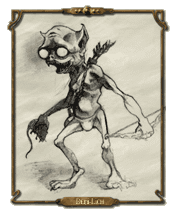
These
small, upright-walking creatures possess unusually large
heads, split by a gaping maw of razor-sharp teeth. They
are thin-limbed and quick, and, when the need arises,
they are able to move stealthily upon their heavily
padded feet. Also of note is the enormity of their eyes,
which is advantageous to their nocturnal nature; kites
prefer to both hunt and travel at night. These dreadful
little beasts habitually wear little clothing, as their
skin is thick, tough and well suited to life out of
doors.
The
kite dwell within forested regions, existing in small
communities of two to seven family units. Hollowed trees
and shady glades are their preferred choices for dens,
although they have, on occasion, been discovered
inhabiting small, hidden caverns. Kite dwellings are
well hidden, for the protection of the females and
children, who rarely wander far from the den.
Through
our observations we gleaned that the kite male occupies
much of its time with hunting, for the kite prefer flesh
and warm blood above all other manner of sustenance.
Although their diet primarily consists of wild hare,
boar and an occasional bear, it was our grievous task to
observe that elven flesh seems to be a preferred
delicacy of the kite. Through close studies of the hunt,
we now know that kites are malicious in nature and enjoy
as much the sport of tormenting their prey as they do
the actual killing.
Should
a group of unwary travelers have the great misfortune of
being discovered by a kite hunting party, they will
shortly become surrounded by the stealthy beasts. As the
shadows of evening deepen, the kite shall commence a
most disturbing assortment of otherworldly shrieks and
howls. This clamor shall proceed first from one
direction, then another, as the kite endeavor to terrify
and confuse their intended prey. Progressing with much
malevolence, the kite will begin to fire barrages of
small arrows into the group, attempting to generate
chaos or perhaps cripple a party member. When
successful, naive travelers scatter blindly in panic,
allowing the Kite to attack and kill each individual
with relative ease.
One
can typically overpower a kite, if encountered
individually. Yet one must be on constant guard against
discovery by a hunting party. Armed with tiny swords and
bows, groups of kite are quick, vicious and will attack
without mercy.
|
Siren
Spider

The
Siren Spider is one of Arcanum's more deadly creatures.
Standing nearly 7 feet tall, this terrible vision
possesses the upper torso of a female human, but walks
upon the eight legs of an arachnid. The very sight of
this monstrosity, which is known to inhabit the desolate
Vendigroth Wastes, is more than enough to weaken all but
the most courageous of men.
Until
recently, it was believed that man served as little but
the creature's favored prey. Through previously
documented encounters, we knew that on occasion, the
female siren spider would call a man out of his tent in
the night, promising, in the words of the honorable Sir
Gregor Seamus Darton, "unspeakable pleasures in the
very voice of irresistible allure." If the victim
was found at all, they were usually little more than a
withered, emaciated husk. What had not formerly been
revealed was precisely how the terrifying creature could
lure a man into its clutches or by what means death was
served to him. Through our studies however, we have
brought the truth to light.
As
none had ever been seen, it was assumed that the male
Siren Spiders were lone wanderers, or perhaps overseers
of the young. We have discovered that this is not the
case. In fact, no male of the species exists in any
capacity or form. Through whatever process the Siren
Spiders were originally brought into existence, be it
the result of some dark and twisted magick or the curse
of an angered god, their genus was left incomplete. As
no male of the species exists, the creature has adapted
an ingenious, and terrifying way to ensure the longevity
of its kind.
When
the female is ready to mate, she seeks out an encampment
of men. As night descends, she transforms herself into a
vision of womanly beauty, calling out to the one she has
chosen. The call itself, being a thing of magick, is
irresistible except by the most powerful of mages, and
the man is led easily away from his companions. When the
victim finally comes to her, she throws herself upon him
in joy and thanksgiving at having been found, doing all
in her power to inflame his fervor. Men, being men, are
particularly vulnerable to this sort of attack, whether
magickal or otherwise. The outcome is rarely in doubt.
Once
the victim has served his manly purpose, the siren
spider resumes her true form. She falls upon the
defenseless, naked man, holding him fast with her eight
anthropoid legs as she injects him with her deadly
poison. The man ceases his struggles quickly, at which
point the depraved beast proceeds to feast upon the
blood from his lifeless body, draining it until it is
nothing but a lifeless shell.
The
siren spider does not rest after its endeavors, but
moves quickly to seek out a cave, proceeding to line the
walls and ceiling with her strong, sticky webbing.
Within a few days, the murderous female will produce a
clutch of eggs, each being equal in size to the head of
a man, which she places upon the padded walls of her
nest. She then stands guard over her clutch for several
months, guarding them vigilantly against Vendigroth's
many predators until they hatch, at which point she
offers herself up, and is devoured by her young.
|
| Werewolf
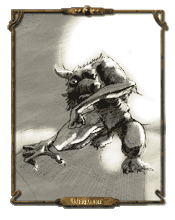
My
colleagues and myself had many discussions regarding the
study of the werewolf for this compendium, as
Lycanthropy is best classified as an affliction, rather
than an actual creature. Yet after thorough
investigation, we now believe its inclusion within these
pages is appropriate. Lycanthropy
is a rare affliction which, for some reason as yet
unknown, only affects those of human descent. A person,
man or woman, afflicted with Lycanthropy, is generally
unaware of the circumstance, and exists within polite
society by day. As night falls however, the individual
transforms into a werewolf. Werewolves
are gigantic, bi-pedal creatures. They are covered head
to toe in thick fur and bear a distinct resemblance to
the vicious garoul. The strength of a werewolf equals
that of an ogre and its sharp claws and powerful jaws
enable it to eviscerate its prey effortlessly. Once
in werewolf form, they become mindless killers,
attacking and devouring anything and anyone they happen
upon. As morning dawns, human form is resumed and they
awaken, unaware of what has happened in the night, but
often covered in blood or surrounded by the dead remains
of their loved ones .A
person thus afflicted rarely survives for long. In most
instances, they are discovered and destroyed, or killed
while in werewolf form, at which point they revert back
to their human shape, revealing their true identity. In
rare instances, an individual infected with Lycanthropy
is able to exist undetected for a longer period of time.
Once the disease has been present for several years, the
werewolf transformation becomes permanent and human form
is no longer attainable, even through death It
has long been debated how the disease is spread from one
individual to another. Some believe that it is through a
gypsy curse, others that it is through the werewolf's
bite. From our studies, we have determined that the
latter is true. The
origin of the disease is not known, and according to our
research, pre-dates written history in Arcanum. It has
been speculated that Lycanthropy was a more virulent
disease in years past as ancient tomes bear record of
packs of werewolves roaming the countryside. No true
cure, aside from death, has ever been found. Although in
recent years, rumors have abounded that the Master Mages
of Tulla may possess a cure for Lycanthropy. |
Lich

Lich.
The very mention of this unnatural creature strikes
terror into the hearts of man, for the beast was itself
once a mortal being, and now has been transformed, by
its own hand, into living death. Only
the mage of rare power is capable of transforming
himself into a lich, and the grim possibility of
failure, the consequence being eternity as a demi-lich,
deter most from even attempting the forbidding and
arcane right. When a lich is first created, it appears
in every sense as the being it was as a mortal, both in
intellect and form. It is only through time that the
differences begin to display themselves to those who
would observe. Slowly, the sinister magicks that gave
birth to the unnatural being begin to twist and deform
the lich, causing the facial features to become sunken,
gaunt and skull-like and the body and mind to decay. As
the years pass, the lich alters appearance completely,
no longer resembling a mortal being, it is now purely a
living skeleton with huge, sunken eye sockets and long,
bony limbs held together by the dried sinew that was
once its skin. Likewise the once great mind that
controlled the lich has deteriorated into that of a
crazed, yet immensely powerful beast, attacking anything
unfortunate enough to cross its path, for a lich retains
its full knowledge of magickal spells, no matter the
stability of its mind. It
seems beyond reason, especially in this age of
enlightenment, that a mage would willingly choose to
transform himself into such a monstrosity. I have done
much research on the subject and found that, in the
creation of a lich, there is usually a specific driving
reason behind the choice. First and foremost there are
those among us who fear death greatly, and would go to
any length to save themselves from its cruel hand. For a
select few, transformation into a lich grants the
immortality they so desperately seek. The lich that
results from this vein of thought survive purely for
their own ends, existing to terrorize and destroy those
left living. These are truly the most dangerous form of
the beast. On
the other hand, there are those individuals throughout
history who have transformed themselves in order to
serve a higher purpose, perhaps that of guarding a
specific sacred item, or protecting an area from some
ancient bane or curse. Those who had a task to perform
that would require their immense magickal powers for a
much longer period of time than their mere lifespan
would provide. A lich of such history, while still
terrifying, is usually benign unless disturbed directly.
They are most often found in ancient ruins or secret
caverns, guarding items long forgotten. It
is believed that the ancient wizard K'an T'au has become
just such a lich. Legend has it that he secluded himself
in his great castle, S'nel N'fa many generations ago and
attempted to transform himself into a lich so that he
might forever protect the elven staff of great power
that he is said to have possessed. K'an T'au was a great
wizard, highly studied in many schools of magick, most
notable were his accomplishments in necromancy and
summoning. Many have gone in search of the staff of K'an
T'au, and most of these adventurers have never been
heard from again. It is highly possible that K'an T'au
succeeded with his dark task, and even now stands guard
over his most prized possession, a ghastly, nightmarish
creature awaiting the next thief foolhardy enough to
enter its domain. |
| Demi-Lich
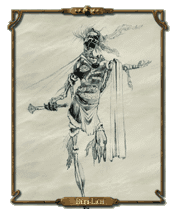
Throughout
history there have been those that have sought
immortality at any cost. Many have searched in vain for
the fabled waters of life or begged blessings from the
gods, but a few, who have studied the magickal arts,
have access to an alternate, more sinister means of
achieving their goal. Through spell, incantation and
extraordinary magickal ascendancy, there are those who
have attempted to twist themselves into the form of an
immortal lich. Few have succeeded.
Far
greater in number are those who fail and are doomed to
spend the remainder of their wretched existence in the
form of a demi-lich. It is believed that through some
misspoken word, incomplete gesture, or lack of
capability, many that attempt the transformation reduce
themselves into this incomprehensible monstrosity.
Unlike
the lich, the newly born demi-lich begins to decay
immediately and it is quickly apparent to any observers
what has occurred as the stench of death begins to
emanate from every fiber of the once powerful mage.
Having donned ritualistic trappings of the dead in order
to complete the ceremony, the ungainly demi-lich is
unable to remove them, and thus shall it remain, to
decay within its death shroud, a dirty, filthy creature,
slowly rotting to insignificant dust.
Early
on in its existence, it appears the demi-lich retains
some semblance of humanity in both thought and motion.
However, the incomplete metamorphosis effects some part
of the mind, causing speech to be lost instantaneously,
along with the ability to perform the more powerful
magicks. Yet some form of memory must remain, for it has
been observed that the demi-lich behaves as if in
constant pain. It has been postulated that the demi-lich
might be feeling the pain of its own decay, or, perhaps,
lamenting the bitter memory of its own failure and
inadequacy. Truly, we do not know. And as the years
pass, this perpetual distress drives the demi-lich
further into the realms of insanity. It is not long
before the creature is nothing but a feral beast.
Although
a demi-lich is but a mere shadow of a powerful mage, we
have observed that they, in the early stages of their
transformation, still command considerable magickal
powers, and therefore pose a significant threat. A newly
created demi-lich usually has the ability to cast
moderately destructive spells. With age and decay it
begins to lose its mind, and, ultimately, its powers.
Our
work in the field has revealed that a demi-lich who is
nearly decayed to dust will nevertheless attempt to do
you harm. Due to the monstrosity's lack of strength,
most victims will likely survive the ordeal. However,
should you happen upon one with most of its faculties
about it, might I offer the pertinent advice of
protecting oneself against magick as swiftly as
possible, and leaving the vicinity with the greatest of
haste. |
Shiverbit

Several
different specie of wolf reside within Arcanum, and
while all are aggressive, predatory creatures, most pale
in comparison with the fearsome shiverbit.
This
ferocious wolf makes its home upon the icy passes and
steep slopes that join the Stonewall and Grey Mountain
Ranges. One of the largest wolves in existence, this
stalwart creature boasts thick fur which is white to
light grey in coloration and provides both excellent
camouflage and ample protection from the extreme
temperatures found in its frozen, hostile domain.
Appearing more intelligent than the common wolf, the
shiverbit is cunning, agile and very deadly.
The
shiverbit can most often be found living in family
groups, or packs, of 4 to 8 adults, dominated by a
single male and female animal, although we have
documented the occasional lone adult male. Within the
pack, the dominant pair are the only members to produce
pups, and on average generate one litter of four to six
pups per year. It is our estimation that nearly half of
all shiverbit pups do not make it to adulthood, falling
victim to numerous perils presented by the harsh
environment in which they live.
As
with most wolves, the shiverbit possesses magnificent
pack hunting capabilities, being both stealthy and fleet
of foot. Its crushing jaws are immense, able to tear
through bone as if through twigs and it is highly
territorial. Yet what truly sets this creature apart
from its brethren is its remarkable defense mechanism
used to deter natural enemies such as the polar bear,
frigidon and yeti. To adapt to its hostile environment,
the shiverbit has developed the ability to render its
enemies harmless by freezing them solid.
What
has confounded those of us that have studied the beast,
is exactly how it manages to do this. Common belief
through the millennia has been that the shiverbit
possessed innate magickal abilities, enabling it to
freeze its tormentors at will. With the advent of the
new schools of reason and science, a few have begun to
entertain thoughts that this capability is not at all
magickal, but rather some form of poison or chemical
contained within the wolf, a technological, not magickal
attribute.
It
has been noted that the shiverbit must physically bite
the victim before the freezing process takes place. This
in and of itself would lead one to suspect non-magickal
means, as it is common knowledge that magick is a force
of will, and physical contact is unnecessary. Yet as I
pen these pages, although proponents for each side are
extremely vocal, neither theory has been substantiated,
as no one has, as of yet, been able to capture a live
beast for study. |
| Oregolem
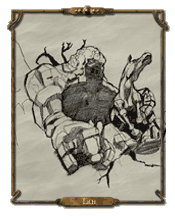
How
is it that we define life? For some, it entails a
particular state of perception and reason, for others a
mere biological and chemical state, and for others
something different. There are those who would not
classify the lifeless husk of the undead mummy as alive,
but can you say the same of the immortal, fiendish
vampires of legend who walked amongst us, reciting our
poetry and seducing our women? What life burns in the
great Spectral Wraiths of the Glimmering, whose bodies
are incorporeal, and whose tongue is as frightening and
incomprehensible as the howling wind?
The
answer, dear friends, is that life is defined in as many
strange, wonderful, and oftentimes horrific ways as
there are creatures that walk our fair land. And perhaps
one of the strangest creatures of all is known as the
Oregolem.
The
Oregolem has been known to inhabit various places within
Arcanum, yet tends to be found mostly within the deepest
caverns of the Grey Mountains, or among the windblown
dunes of the Vendigroth Wastes. The earliest dwarven
histories speak of battles with these fierce and
mindless creatures, which they named Njord Frigg, or the
Furious Mountain. The dwarves feared it because it was
relentless and unstoppable. They feared it because it
was alive, and it was made of stone.
The
Oregolem is a massive creature; specimens have been
known to exceed 18 feet in height alone. They are
humanoid in appearance, with two arms, two legs and a
shapeless head that may or not be split with an
irregular, crooked maw. It walks upright, like a man,
and has an extremely aggressive, and often deadly,
disposition towards anything and anyone who disturbs it.
It does not eat, nor is there any known record of it
mating or producing progeny. They do not speak or make
noise, save from the terrible grinding of the its
massive stone limbs upon one another as it stalks its
prey.
Many
are the stories of Stone Elementals and the wizards who
summon and control them. Make no mistake. Many more are
the stories of foolhardy mages who sought to defeat the
Oregolem with similar magicks, and whose lives were
forfeit because of that shortsightedness. The Oregolem,
from what we can surmise, is no creature of magick. And
although no blood flows within the solid stone of its
rock carapace, it most definitely lives and is best left
to its own devices. Our studies have shown that the only
way to defeat an Oregolem is to literally blast it to
bits, or to hack off those limbs which it might use for
locomotion. It is not at all uncommon for adventurers to
employ dwarven sappers if they believe that Oregolems
might be happened upon.
Advice
for the itinerant traveler who stumbles upon an
Oregolem? Run, my friends, plain and simple. Oregolems,
as invincible as they might seem, are not the fastest
creatures in all of Arcanum. Better be the coward's way
than the crushing death between those great hands of
stone. |
Lethe
Wyvern
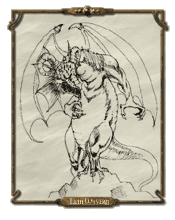
Listen
closely to the tale of a horrific beast. Some say it is
a true monstrosity, others a mere legend. None in our
day and age have encountered the lethe wyvern face to
face… at least none that have survived to tell the
tale.
Many
ancient tomes and texts have been perused in order to
gleam the description lying before you, and while some
differ in their opinions, most agree that this fearsome
beast, which walks upright on thick haunches, is nearly
double the height of a man, and twice as fleet.
Dragon-like in appearance, it is often described as
being colored to match whatever the surrounding
countryside. Expansive wings adorn its shoulders, yet in
all of the research available to me, I have found no
mention or proof that it has the ability to fly.
Diminutive,
viper-like eyes adorn the sides of a large reptilian
face, yet I pray you do not become complacent with an
opinion that this creature can not behold its
surroundings. The tomes I have examined speak much of
the Lethe's ability to see vast distances, and even the
slightest of motions will send its lengthy neck whipping
around to determine if the thing sensed might serve as a
worthy meal.
The
lethe wyvern is described as consuming all manner of
flesh, that of both man and beast. Its numerous rows of
razor-like teeth are undoubtedly most helpful in this
endeavor, and it is believed to possess the most
terrible and sharp claws, which are most certainly used
for ripping prey asunder.
Yet
the most fearsome quality of this monster is the venom
carried deep within its deadly fangs. Each account I
discovered bespoke the same tale of the Lethe's
treacherous venom, which poisons not the body, but the
mind. The Lethe will envenom its prey repeatedly,
causing the intellect to degenerate, and thus forever
altering the mind of the hapless creature. Soon, the
intended prey is too lack-witted to flee, and it is then
that the lethe may enjoy a live meal at its leisure.
As
a fact, the only accountings of survivors that I came
across described once intelligent gentlemen, now become
blithering fools, who required care to perform even
their most basic needs until the end of their days.
Whether or not there is an antidote to this deadly and
degenerative poison is unknown. |
| Kuljin

It
is oppressive, malevolent, paralyzing. It surrounds us
completely, pressing in from all sides, bringing with it
visions of terror, torment, death. One's blood runs
cold, slowly the hair stand's on end and the flesh
begins to creep. The senses are crippled, apprehension
builds quickly, the heart begins to palpitate and panic
ensues as terror's icy claws rip a man's strength
asunder. Darkness remains one of mankind's greatest
fears.
Neither
is this fear unfounded, as it is an instinctual reaction
long built into our species for good purpose. One
example of the wisdom driving this innate proclivity may
be attested to by any dwarf, for it is their race who
most often encounters the deadly kuljin, deep within the
darkest caverns.
These
small, shapeless creatures that inhabit the deep, gloomy
recesses of the underworld have never been viewed by the
light of day. To adapt to their subterranean existence,
the kuljin are colored black as pitch and possess razor
sharp claws. Traveling in small packs, and feeding on
all manner of flesh, it is speculated that the kuljin
retain several rows of small, razor sharp teeth, for
they devour their prey with amazing quickness. >From
what we were able to ascertain, these creatures are
small in stature, and bipedal, or ape-like in form,
although a specimen has never been examined closely
enough to give legitimacy to this opinion.
The
kuljin can see perfectly in the complete absence of
light, which makes them excellent hunters, well suited
for their environment. Thankfully for us, this is also
their greatest weakness, as light not only blinds them,
but appears to cause them extreme pain. Consequently,
kuljin flee in terror from any source of light. But woe
to the unfortunate soul whose torch sputters and dies
when the kuljin are about; his life is as good as
forfeit.
While
researching these vicious creatures deep within a dark
and twisting cave, one of our pack animals tripped,
landing upon the lantern tied to its side. Being at the
rear of our team, the beast was plunged into darkness,
whereupon a pack of kuljin rushed upon it immediately.
Its screams of terror and pain bombarded our ears and
filled cavern with chaos. We rushed back to save the
poor beast, but were too late. As we stumbled back, the
kuljin retreated from the light, and the grisly sight
that met our eyes will surely haunt my dreams for years
to come.
There
before us on the ground, barely recognizable and still
writhing in agony, was the partially devoured pack
animal. It's flesh stripped away to the bone on its
haunches, legs, head and neck, devoured in a matter of
moments by the opportunistic kuljin. The chill that went
down my spine and the terror that gripped my heart was
suffocating as I moved to put the beast out of its
misery.
I
now know firsthand, why it is we fear the dark. |
Holy
Defiler
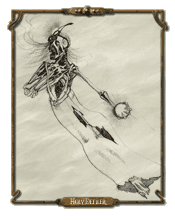
Evil
wears many faces. Often, sadly, it is known to wear the
face of the good and the righteous. Or, in the most
sorrowful cases, it will twist the true face of goodness
into something unrecognizable, horrible, completely
devoid of its former nature.
Such
has been the fate of what has come to be called the Holy
Defiler. These tormented souls, like the lich, were once
great and powerful mages. And, like their spiritual
brethren, they have been become evil through the use and
manipulations of the darkest magicks. What sets the Holy
Defiler apart from the rest of its kind is what it was
before, and the sad realization of what has been lost in
its shadowed transformation.
Holy
Defilers are called so because they were once holy men
or white necromancers…they practiced the more
benevolent magicks, concentrating on those spells which
heal the body and the mind. Unfortunately, as with all
things, there is always a darker side to even the best
of things. Holy Defilers, from what we can ascertain
from scattered books and accounts, seem to have looked
too closely at the dark reflection of white necromancy,
those spells of soul poisons and conjuring of spirits,
and were eventually lost to the evils which they
discovered in those depths. In time, they were overcome
with their obsessions and became something abominable.
Holy Defilers surround themselves with helpless servants
of all kinds, broken under the great power of the
creature and living only to sacrifice themselves for
their master's well being.
During
our travels, we were fortunate enough to survive a foray
into the Bangellian Deeps, and there we happened across
a most peculiar conflict. A lumbering Feraloch had
discovered the lair of a Holy Defiler and its minions,
an enslaved group of orcs. We watched in horror as the
raging beast tore into the unsuspecting and mindless
orcs, eviscerating them with great sweeps its claws,
working its way toward their master. And yet, not
moments after the orcs had fallen to the ground they
were up again and fighting, healed or resurrected by
their twisted lord who stood apart from the fray,
unmoving and fearless. In time, the sheer numbers of the
orcs were more than enough for the unfortunate Feraloch,
and he was eventually torn limb from limb. We made a
hasty departure before we too suffered the same fate.
Pure
is the evil that uses the face of goodness for such dark
ends. May you never have to gaze upon it. |
| Gyr-Dolour

It
is often the lot of many to suffer greatly throughout
their lifetimes, as the result of one tragedy or
another, and through this suffering, to experience the
very depths of despair, guilt, desolation, and utter
hopelessness. Such occurrences of devastating emotions
have plagued men and women throughout time, bringing
them to the lowest points in their existence, and it is
at these times that they become prime targets for the
vile gyr-dolour.
Reptilian
in appearance and diminutive in nature, the gyr-dolour
are physically weak creatures, standing merely one
quarter the height of a man. Their coloring is dark,
varying from muted browns to black and their bodies are
covered in small, smooth scales from head to tail. The
gyr-dolour possess two undersized forearms, which they
do not appear to make use of overmuch and they walk
upright, upon their hind legs, enabling them to move at
a quick pace when the need arises. Small, dark eyes
adorn either side of a long snout, whose short, sharp
teeth see use merely as a defensive weapon, for the
gyr-dolour feed not upon plant nor animal, but upon
those dark and powerful emotions which emanate from our
very being.
These
creatures can sense the emotional state of their prey
from great distances, and are often seen scurrying about
the edge of town at times of great sorrow, such as the
death a beloved wife, or child, waiting for a chance to
find the sorrowful alone, so that they may feed.
It
is the nature of the tormented soul to seek solitude,
and in doing so, they open themselves, and perhaps
welcome, the pestilence of the gyr-dolour. When a pack
of gyr-dolour encounter a tormented soul, they slowly
approach the person, cooing in an odd, sorrowful tone.
It is believed that they resonate the despair back to
the person, forcing them into even darker depths, until
they have given up all hope and become oblivious to the
world around them, so lost in the depths of despair are
they. It is then that the gyr-dolour take up residence
in a loose circular pattern around the prey to feed.
They never touch the victim, staying just out of reach
at all times, and in fact never physically harm their
prey. It is in the mental capacity that the victim is
harmed. Forced to relive over and over again memories of
darkness and despair, resonated and amplified for the
gyr-dolour's own needs until the victim's mind and body
waste away and death ensues.
Once
the gyr-dolour have begun feeding upon their prey,
interrupting them can be a difficult and often deadly
task. For when provoked into attack, their blows cause
little physical damage, but instead seem to drain the
strength right out of a man. They will continue to
attack until the rescuer is unconscious upon the ground,
at which point they will return their full attention
back to the prey, no longer concerned. This nonchalance
on their part may stem from experience, for small
wyverns and various carrion eaters, even death lanterns,
have been known to lurk about feeding groups of
gyr-dolour, waiting to clean up the scraps, or take
advantage of any failed rescue attempts
.I
was unable to ascertain the exact process used by the
gyr-dolour to feed upon their prey, noting only that the
more sorrowful and tortured the prey, the healthier and
more plentiful were the gyr-dolour. After several months
of study, it is my opinion that the gyr-dolour possess
some form of magickal ability that enables them to gain
sustenance from the powerful mental images and forces at
work in the tormented mind. The gyr-dolour are truly one
of Arcanum's most vile creatures.
|
Shadow
Crawler

They
invoke sheer terror in some, mere annoyance in others,
but they are never far from us. I have a colleague who
is most adamant in his belief that we are never more
than three feet from one at any given moment, yet they
most often remain hidden away from our prying eyes,
seeking nothing from us, but to remain undisturbed in
the shadowy nooks and crannies of our world. Even when
confronted, most are relatively harmless and easily
dispatched, but that cannot be said of all specie of
spiders. One very significant departure from this rule
can be found in the dreaded shadow crawler.
The
shadow crawler, at the basest comparison, it is a
standard spider in appearance and in habitat, preferring
the shadowy darkness to the bright light of day and
feeding upon its prey in a most unpalatable manner. Yet
one encounter with this particular spider, and it is
quite evident that the similarities end quickly, for
this monstrous example of the arachnid species is equal
in height to a full grown halfling, it's eight thick,
segmented legs spread out to a daunting width. It is
black in coloration, yet it is not solid, rather the
shadow crawler appears as some partially transparent
ethereal apparition, lending it a great advantage in
concealing itself. It prefers caves and deep crevices as
lairs, but has also been found inhabiting ancient crypts
and burial tombs.
Hunting
habits are another area where the shadow crawler
differentiates itself from the common spider. Unlike its
brethren, who lie in wait for prey to become caught fast
in their fine spun webs, the shadow crawler must hunt
for its food, as it is incapable of producing a webbing
substance. It does this by wandering from its lair to a
location that might prove fruitful and concealing itself
from sight, usually deep in shadow. The beast is a
patient hunter, as we witnessed our specimen remain
practically motionless for nearly ten hours before a
possible meal, in this case a young forest ape, happened
along.
The
encounter was both brief, and brutal; the spider sprung
forward as the ape passed, knocking it to the ground
with its powerful front limbs. The ape never had a
chance to recover and the shadow crawler all but pounced
upon the hapless creature, sinking razor sharp mandibles
into the ape repeatedly, no doubt injecting a stunning
poison. The forest ape ceased its struggles quickly, and
the shadow crawler set about draining all sustenance
from its meal, leaving behind nothing but a withered
husk. What shocked and amazed us all the more though,
was what happened afterward.
A
large crashing was suddenly heard from farther up the
path, the spider turned, having just finished its meal,
just in time to encounter the rather large group of
apes, led by a huge male specimen. The troupe of apes
stopped dead, obviously to assess the situation, and
when the lead male spotted the drained corpse upon the
ground, he began to beat his chest and emit a most spine
tingling and ferocious howl. He was quickly joined by
the other members of his group, and they began to
advance upon the spider.
Seeing
itself at a distinct disadvantage, the spider did not
flee, as I had anticipated, but backed away slowly from
its meal. Suddenly, the fresh corpse began to twitch and
shudder. Within moments it stood, a macabre sight,
placing itself between the two adversaries, preparing to
defend the creature which had just stolen its life!
This
seemed to enrage the apes further and they quickly
advanced towards the spider, only to be attacked by the
ape zombie, from which they recoiled as if in horror.
One of the males managed to get past the reanimated
nightmare, whereupon the spider attacked and overcame it
much as it had done earlier with his companion. No
sooner had this second ape been dispatched, than it too
joined the ranks of the undead army. This seemed too
much for the apes, and they quickly turned and fled back
down the path, whereupon the corpses collapsed upon the
ground and the shadow crawler proceeded to feed upon its
newest victim.
Needless
to say, we have found the shadow crawler to be a highly
unique arachnid, best avoided at all costs by the
citizens of Arcanum. |

|
|
|